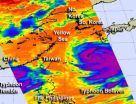Panda preferences influence trees used for scent marking
2012-08-28
(Press-News.org) As solitary animals, giant pandas have developed a number of ways to communicate those times when they are ready to come into close contact. One means of this communication occurs through scent marking. A recent study by San Diego Zoo Global researchers, collaborating with researchers at the Institute of Zoology, Chinese Academy of Science, indicates that pandas make clear and specific choices about what trees are used for scent marking.
"Variables affecting the selection of scent-marking sites included bark roughnesss, presence of moss on the tree trunk, tree diameter and distance to the trail," said Ron Swaisgood, Ph.D., co-head of San Diego Zoo Global's Giant Panda Conservation Unit. "These choices have clear effects on the scent signal, making it last longer, be detected from further away, or otherwise enhance its communication efficiency. We are not surprised that pandas are efficient with their use of chemo-signals, as mounting evidence suggests that many aspects of giant panda life history are constrained by their energetically poor diet."
This study, which was recently published in "Animal Behavior," confirms that old-growth forest and other factors like tree type are important for maintaining habitat that will support giant panda conservation.
###
The San Diego Zoo Institute for Conservation Research is dedicated to generating, sharing and applying scientific knowledge vital to the conservation of animals, plants and habitats worldwide. The work of the Institute includes onsite research efforts at the San Diego Zoo and the San Diego Zoo Safari Park (historically referred to as Wild Animal Park), laboratory work at the Arnold and Mabel Beckman Center for Conservation Research, and international field programs involving more than 235 researchers working in 35 countries. In addition to the Beckman Center for Conservation Research, the Institute also operates the Anne and Kenneth Griffin Reptile Conservation Center, the Frozen Zoo® and Native Seed Gene Bank, the Keauhou and Maui Hawaiian Bird Conservation Centers, Cocha Cashu Biological Research Station and the Desert Tortoise Conservation Center.
The Zoo also manages the 1,800-acre San Diego Zoo Safari Park, which includes a 900-acre biodiversity reserve, and the San Diego Zoo. The important conservation and science work of these entities is supported in part by The Foundation of the Zoological Society of San Diego.
ELSE PRESS RELEASES FROM THIS DATE:
2012-08-28
The extent of the sea ice covering the Arctic Ocean has shrunk. According to scientists from NASA and the NASA-supported National Snow and Ice Data Center (NSIDC) in Boulder, Colo., the amount is the smallest size ever observed in the three decades since consistent satellite observations of the polar cap began.
The extent of Arctic sea ice on Aug. 26, as measured by the Special Sensor Microwave/Imager on the U.S. Defense Meteorological Satellite Program spacecraft and analyzed by NASA and NSIDC scientists, was 1.58 million square miles (4.10 million square kilometers), ...
2012-08-28
PULLMAN, Wash.—More than 40 plant-based compounds can turn on genes that slow the spread of cancer, according to a first-of-its-kind study by a Washington State University researcher.
Gary Meadows, WSU professor and associate dean for graduate education and scholarship in the College of Pharmacy, says he is encouraged by his findings because the spread of cancer is most often what makes the disease fatal. Moreover, says Meadows, diet, nutrients and plant-based chemicals appear to be opening many avenues of attack.
"We're always looking for a magic bullet," he says. "Well, ...
2012-08-28
This press release is available in Spanish.
A U.S. Department of Agriculture (USDA) scientist has found a "green" alternative to a type of fertilizer additive that is believed to contribute to the accumulation of heavy metals in waterways.
Ornamental nursery and floral crops require micronutrients like iron, manganese, copper and zinc. But fertilizers that provide these micronutrients often include synthetically produced compounds that bind with the micronutrients so they are available in the root zone.
The most commonly used compounds, known as chelating agents, ...
2012-08-28
WASHINGTON — The origin of Cerataspis monstrosa has been a mystery as deep as the ocean waters it hails from for more than 180 years. For nearly two centuries, researchers have tried to track down the larva that has shown up in the guts of other fish over time but found no adult counterpart. Until now.
George Washington University Biology Professor Keith Crandall cracked the code to the elusive crustacean's DNA this summer. His findings were recently published in the journal "Ecology and Evolution," and his research was funded by the National Science Foundation and the ...
2012-08-28
NASA satellites are providing imagery and data on Typhoon Tembin southwest of Taiwan, and Typhoon Bolaven is it barrels northwest through the Yellow Sea. In a stunning image from NASA's Aqua satellite, Bolaven appears twice as large as Tembin.
NASA's Moderate Resolution Imaging Spectroradiometer (MODIS) instrument that flies onboard the Terra satellite captured a remarkable image of Typhoon Tembin being dwarfed by giant Typhoon Bolaven at 0240 UTC on Aug. 27, 2012. The visible image shows that the island of Taiwan appears to be squeezed between the two typhoons, while ...
2012-08-28
EAST LANSING, Mich. — Mechanisms that protect plants from freezing are placed in storage during the summer and wisely unpacked when days get shorter.
In the current issue of the Proceedings of the National Academy of Sciences, Michael Thomashow, University Distinguished Professor of molecular genetics, demonstrates how the CBF (C-repeat binding factor) cold response pathway is inactive during warmer months when days are long, and how it's triggered by waning sunlight to prepare plants for freezing temperatures.
The CBF cold response pathway was discovered by Thomashow's ...
2012-08-28
COLUMBIA, Mo. — A newly defined genre of literature, "teen sick-lit," features tear-jerking stories of ill adolescents developing romantic relationships. Although "teen sick-lit" tends to adhere to negative stereotypes of the ill and traditional gender roles, it also explores the taboo realm of sexuality, sickness and youth, says the University of Missouri researcher who named the genre in a recent study. Readers and their parents should be aware of how the presentation of disease and disability in these stories can instill prejudices and enforce societal norms in young ...
2012-08-28
COLUMBIA, Mo. – Separated and divorced couples are increasingly using emails, texting and social media to communicate with their ex-partners about their children. However, when ex-spouses use that technology to withhold or manipulate information, the children are the ones who suffer most, according to a University of Missouri family studies expert. A new study suggests divorce counselors should teach separated parents effective ways to use communication technology in order to maintain healthy environments for their children.
Lawrence Ganong, a professor of human development ...
2012-08-28
Living in poverty is often accompanied by conditions that can negatively influence cognitive development. Is it possible that being bilingual might counteract these effects? Although previous research has shown that being bilingual enhances executive functioning in middle-class children, less is known about how it affects lower income populations.
In a study forthcoming in Psychological Science, a journal of the Association for Psychological Science, psychological scientist Pascale Engel de Abreu of the University of Luxembourg and colleagues examine the effects of speaking ...
2012-08-28
OAK BROOK, Ill. – August 27, 2012 – The American Society for Gastrointestinal Endoscopy's (ASGE) Preservation and Incorporation of Valuable Endoscopic Innovations (PIVI) initiative examines real-time imaging of Barrett's esophagus in an article appearing in the August issue of GIE: Gastrointestinal Endoscopy, ASGE's monthly peer-reviewed scientific journal. This PIVI is one in a series of statements defining the diagnostic or therapeutic threshold that must be met for a technique or device to become considered appropriate for incorporation into clinical practice.
Barrett's ...
LAST 30 PRESS RELEASES:
[Press-News.org] Panda preferences influence trees used for scent marking


